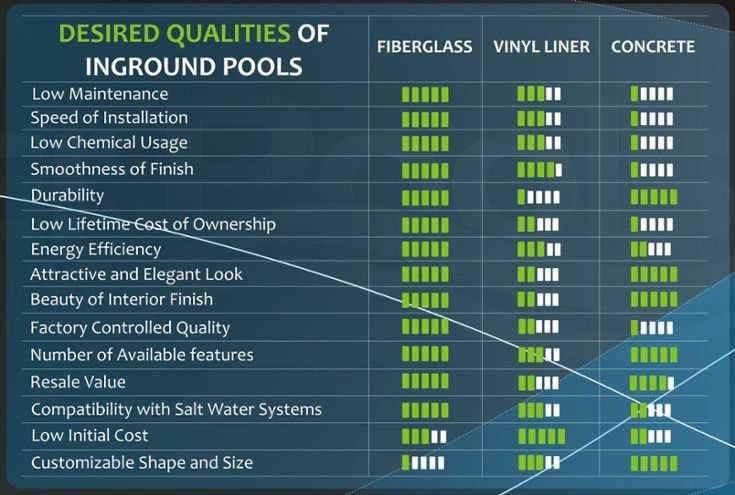What Type of Inground Pool Is Best for Me?
As any woman in a clothing store will tell you, there's no such thing as "one size fits all." There are too many variables—the length, the fabric, the cut. The same "universal" shirt is too small on one person and too big on another.
When you're looking for an inground pool, there's no universal "best" pool type either.
Hold on... Shouldn't we at River Pools say that there is? We specialize in fiberglass pools, after all. Well, no.
Every person has different goals for their pool, different boundaries, and different families.
What are your priorities?
What space are you working with?
How big is your family, and how big might it get in the future?
All 3 pool types have pros and cons. Our goal is to help you evaluate those pros and cons so you can decide which one is the best inground pool for you and your family.
Areas to compare:
Maintenance
Install speed (and messiness)
Durability
Attractive
Upfront cost and long-term cost
Customizability
Surface texture
Which pool type has the least maintenance?
Concrete
Concrete pools need a lot of help. Porous plaster both leaches alkalinity into the water and welcomes algae. Booo.
Many concrete pool owners hire a pool cleaning service to take care of the weekly upkeep.
Of course, you should always have a professional for acid washes and resurfacing. It's safer that way.
Running the pool’s pump/filter system daily
Cleaning out debris
Balancing the water chemistry weekly
Steel-brushing the pool weekly
Acid washes every 3–5 years
Resurfacing and replacing the waterline tile every 8–12 years
Vinyl Liner
The liner is less porous and doesn't affect the water chemistry. However, algae can pop up in corners with no circulation.
The biggest maintenance issue is replacing the liner.
Running the pool’s pump/filter system daily
Cleaning out debris
Balancing the water chemistry weekly
Brushing the pool weekly
Replacing the liner every 5–9 years
Fiberglass
Fiberglass pool gelcoats are much less porous than plaster—smooth and algae-resistant!
The gelcoat doesn't affect the water chemistry, and (if made and maintained right) it should never need refinishing.
Running the pool’s pump/filter system daily
Cleaning out debris
Balancing the water chemistry weekly
Brushing the pool weekly
Which pool type has the easiest installation?
Concrete
Concrete pools take the longest to build. At minimum, 3 months. Often longer.
And your yard is in chaos the whole time. There's often a lot of overspray, which creates a huge mess.
Vinyl Liner
Vinyl liner pools take about 4–8 weeks to build.
That's a bit longer than fiberglass pools, but still much less than concrete pools.
Fiberglass
Ready for this?
A fiberglass pool installation takes only 3–6 weeks on average, and that time is almost all patio work. (Of course, this time can vary depending on the project.)
The pool itself is full of water and swim-ready by day 2.
This is because fiberglass pool shells are pre-manufactured in a factory, from a mold. We don't build it on-site in your backyard. (That saves some mess as well as time.)
Which pool type is the most durable?
Concrete
Real talk: the structure of a concrete pool will probably survive Armageddon.
The interior finish is sturdy too, but mortal.
Depending on the type of material (plaster, aggregate, or tile), you'll need to refinish the surface every 8–12 years. This usually includes replacing any waterline tile, too.
Salt chlorine generators also don't do well with plaster or aggregate surfaces. The salt in the water wears away at the plaster faster, meaning you have to resurface even sooner.
Vinyl Liner
Vinyl liner pools are the least durable of the three types, by far.
The liner has to be replaced every 5–9 years. (You'll also find that the warranty is wayyy pro-rated. Ugh.)
Beware of leaks, especially with metal wall panels. They'll rust—all the way through, if it goes on long enough.
Polymer wall panels can become brittle and break.
Salt systems are extra bad for metal wall panels in leaking cases. However, the salt doesn't impact polymer wall panels.
Fiberglass
The structure of a fiberglass pool stands up well to movement in the surrounding earth. Its natural flexibility lets it stay in place without cracking.
If properly manufactured and maintained, the gel coat surface should never need to be refinished either.
Which pool type is the most attractive?
Concrete
Concrete pools are the "classic" look. Even simple white plaster looks good if well maintained.
Of course, there are also the pool owners that go all out, like the Olympic-length pool or the full-on natural grotto aesthetic.
Basically, concrete pools only look bad when they're neglected.
Vinyl Liner
Vinyl liner pools tend to look inexpensive. To be fair, that's because they are.
You can always upgrade! High-quality add-ons and surroundings can transform a liner pool.
However, those upgrades cost a pretty penny. It basically negates the initial savings and puts you up to fiberglass-pool-level expenses. (Still cheaper than a concrete pool, though.)
Fiberglass
Fiberglass pools look great with both simple and complex aesthetics.
Which pool type is the most customizable?
Concrete
Concrete pools are crazy customizable.
You know those pools you've seen that is shaped like a guitar? Or a duck? Odds are good that they're concrete.
Vinyl Liner
Vinyl liner pools can also be designed in custom shapes.
However, keep in mind that the liner has to be cut and fit to match that shape. That can make intricate shape detailing difficult.
Fiberglass
Fiberglass pools are limited to the shapes and sizes of preexisting molds. They generally don't get bigger than 16 by 40 ft.
However, there are so many options out there. Tanning ledges, bench seats, deep ends...pretty much everyone can find a design they love.
And the sky is the limit with all the other aspects of the pool project—Gelcoat color, patio, water features, accessories, waterline tile, and more.
You can check out our own designs to see examples of fiberglass pool models.
Which pool type costs the least?
For more details, check out our Inground Pool Cost Guide or our blog article How much does an inground pool cost?
The upfront cost of a pool
Concrete
Concrete pools generally cost $50,000–$100,000 upfront.
Vinyl Liner
Most vinyl liner pools cost $35,000–$65,000 upfront.
Fiberglass
Fiberglass pools cost $45,000–$85,000 upfront.
The long-term cost of a pool
Concrete
Concrete pool maintenance will cost about $27,400 over 10 years.
Heavy chemical usage (about $750 a season)
Electrical energy (about $400 a season)
Acid washes every 3–5 years ($450 on average)
Resurfacing and replacing the waterline tile every 8–12 years ($6,000–$10,000)
Weekly pool cleaning service (about $500 a season)
Vinyl Liner
Vinyl liner pools cost about $11,500 in maintenance over 10 years.
Chemicals (about $400 a season)
Electrical energy (about $300 a season)
Replacing the liner every 5–9 years (about $4,500 each time)
Fiberglass
A fiberglass pool only costs about $3,760 in maintenance over 10 years.
Chemicals (about $175 a year)
Electrical energy (about $200 a year)
Which pool type has the best surface?
Concrete
A plaster finish on a concrete pool is rough, especially on kids' skin. Many children have to wear swim shoes in a concrete pool.
Exposed aggregate isn't rough like plaster. However, it's bumpy, and walking on that can be uncomfortable too.
Tile is much smoother than plaster or exposed aggregate. The only potential issue is if a tile loosens or cracks. The sharp edge would hurt if you stepped on it.
Polished aggregate is the smoothest interior finish for a concrete pool. It's aggregate, but the bumpy exterior bits are shaved off, leaving a perfectly smooth surface.
Vinyl Liner
Pool liners are smooth everywhere except for the slight seam where one piece meets another. The bump there is noticeable but not sharp.
Fiberglass
A fiberglass pool Gelcoat is super smooth. Ask to feel a sample!
At River Pools we include anti-slip texture on our steps and seats. It isn't rough at all—just a slight texture to help you keep your balance.
What pool type fits me best?
When it comes to which pool type might be a good fit for you, here's what we've found in a nutshell:
A concrete pool might be a good fit if you...
Have a budget of $70k and up
Need a custom shape or depth, or can't find a fiberglass pool you like
Don't mind spending a significant amount of your spare time and/or money maintaining the pool
Are okay with investing tens of thousands of dollars to keep the pool in working order
A vinyl liner pool might be a good fit if you...
Have a budget of $45k and up
Will only live in the home for two or three years (and can avoid the first liner replacement)
Want the biggest pool for the cheapest price
A fiberglass pool might be a good fit if you...
Have a budget of $55k and up
Can find a fiberglass swimming pool design that meets your needs
Want low maintenance
Want a pool that doesn't cost a fortune in the long run
Want a quick and relatively pain-free installation
With that in mind, if you're interested, you can check out our fiberglass pool designs.


